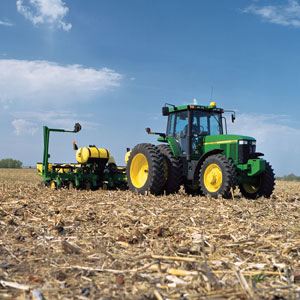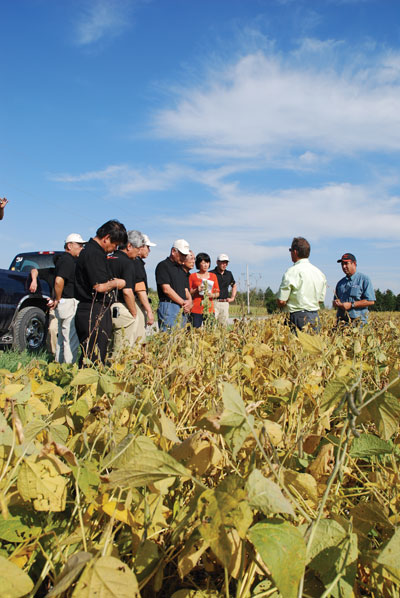
Features
Agronomy
Storage
Nanotechnology in agriculture
Fabric sensors in a field change colour, indicating the arrival of pathogens. Tiny wireless electronic sensors in grain bins detect incipient spoilage, alert the farmer via mobile phone, and begin specific remediation. Specially formulated fertilizers and pesticides act with greater efficacy, allowing less product to be applied.
November 30, 2009 By Heather Hager
Fabric sensors in a field change colour, indicating the arrival of pathogens. Tiny wireless electronic sensors in grain bins detect incipient spoilage, alert the farmer via mobile phone, and begin specific remediation. Specially formulated fertilizers and pesticides act with greater efficacy, allowing less product to be applied.
 |
|
| Fabric made of cellulose and poly-lactic acid nanofibres slowly degrades, releasing agricultural pesticides held within the pores. Scanning electron microscope images courtesy of Dr. Chunhui Xiang, Fiber Science and Apparel Design, Cornell University. |
These are just some of the potential applications of nanotechnology in agriculture that are being explored. “Nanotechnology is the concept of working with materials at a very small scale,” explains Dr. Nils Petersen, director general of the National Institute for Nanotechnology in Edmonton, Alberta. To get an idea of just how small this scale is, one nanometre is one-millionth of a millimetre, or half the width of a strand of DNA. A strand of hair is roughly 100,000 nanometres wide. “At this scale, the properties of materials change tremendously because of the large surface-to-volume ratio and changes in the quantum mechanical behaviour of materials,” says Petersen.
The enormous surface area of nanomaterials facilitates their interaction with other substances, giving the nanomaterials unique properties such as exceptional strength or greater chemical activity. Researchers are exploring new applications for these unique properties, and the field of nanotechnology is expanding rapidly, with applications in areas of medicine, electronics, engineering, computers, energy, environment, plastics, and food science, to name a few. Although discoveries in these areas may be of relevance for agriculture, there is also some direct interest in nanotechnology to aid agricultural production.
Sensing grain spoilage
At the University of Manitoba in Winnipeg, microelectronics and nanotechnology have been combined to create a tiny sensor that can help farmers in the early detection of grain spoilage during storage. The sensor was developed by Suresh Neethirajan, research and development engineer in the Department of Biosystems and Engineering, along with colleagues from electrical engineering, entomology and chemistry. The stand-alone sensor is the size of a dime and can detect parts per billion levels of carbon dioxide and odour-causing chemicals to determine the level and cause of spoilage. “There are two or three major insects in grain,” says Neethirajan. “Each insect produces a specific chemical inside the grain bin. Similarly, if the grain is being infested with fungus, it produces different chemicals. Our particular sensor has seven chips in it and will identify which insect or fungus is causing the spoilage.”
The sensor also measures changes in carbon dioxide to detect incipient and ongoing deterioration of stored grains. Once the cause of spoilage is identified, a specific treatment can be used to correct the problem. “We are also looking at building the sensor to be wireless,” says Neethirajan. He envisions that multiple sensors would be distributed throughout the grain to pinpoint problem areas and would communicate with a central hub. The central hub would automatically update a household computer, website, or personal mobile device such as a cellphone so that a farmer could monitor the grain on a daily basis without having to visit the grain bin. By catching and treating spoilage before it becomes severe, additional benefits might include reduced chemical usage and better grain quality.
Neethirajan thinks that this technology could be available to farmers within two to three years. “We have demonstrated that our sensor works, and we are now focusing on commercializing the technology,” he says. A patent is being obtained, and several companies have expressed interest in licensing the technology.
Controlled-release textiles
In another application, nonwoven fabrics made from nanofibres are being used as a platform for controlled-release technology. The nanofibres are made by electrospinning, which uses an electrical charge to pull a very fine, long fibre from a droplet of liquid polymer. The fibre twists upon itself, creating a fabric. “The high surface area, high porosity and small pore size of the fabric all contribute to its absorption and release performance,” says Dr. Margaret Frey, associate professor in the Department of Fiber Science and Apparel Design at Cornell University in Ithaca, New York.
Frey and colleagues are using cellulose and polylactic acid, a polymer made from cornstarch, to create a biodegradable fabric. The fibres can hold up to 50 percent of their weight in agricultural chemicals such as pesticides; the chemical is gradually released as the fabric biodegrades. In experiments, gradual release was obtained during a four-month period, and the timing of release depended on the fibre’s composition. In greenhouse tests, 4 x 4 mm squares of pesticide-containing fabric placed in the soil successfully controlled whiteflies on bean plants.
 |
|
| Special techniques and equipment and ultra-clean facilities are required to create nanoparticles such as these. Scanning electron microscope images courtesy of Anastasia Elias, Anne Cooper, and Jillian Buriak, National Institute for Nanotechnology, Edmonton. |
Similar nanofibre-based fabrics are being used as a detection technology platform to capture and isolate pathogens. Frey’s research is currently focused on medical and food applications such as detecting Salmonella or Escherichia coli, but in future, the technology may be extended to include other pathogens and diseases. The nanofibres in this fabric are embedded with antibodies against specific pathogens. The fabric can be wiped across a surface and tested to determine whether the pathogens are present, perhaps indicating their presence by a change in colour.
“Research is continuing on both of these projects, and invention disclosures and patent applications have been filed on both of these materials,” says Frey. “With an industrial partner, these inventions could be available for use in three to five years.”
These and other agricultural applications of nanotechnology may be the next step in increasing farming efficiency.
| Regulating nanotechnology
Concerns over the effects of nanoparticles in the environment and on human health have prompted Health Canada and Environment Canada to develop some ground rules for nanomaterials under the Canadian Environmental Protection Act. At the international level, the International Organization for Standardization (ISO) and the Organisation for Economic Co-operation and Development (OECD) are developing standards to facilitate an international regulatory framework for nanotechnology. Nanomaterials have unique properties and behave differently from typical common materials, so it is unknown how their effects might depend on the mass, number, size and shape of particles. Thus, it is necessary to determine if current toxicological evaluations will apply to these materials or if modifications or new methods are required. As a first step, the Canadian government is collecting industry data on nanomaterials’ use, properties, health and ecological toxicity, and water solubility under the Canadian Environmental Protection Act. “We recognize as a scientific community and as an industrial community that there are issues that we have to face and identify before we get a lot of technology into the marketplace. We don’t fully understand yet what parameters we need to measure when we look at the effects of nanomaterials,” says Dr. Nils Petersen, director general of the National Institute for Nanotechnology in Edmonton, Alberta. |